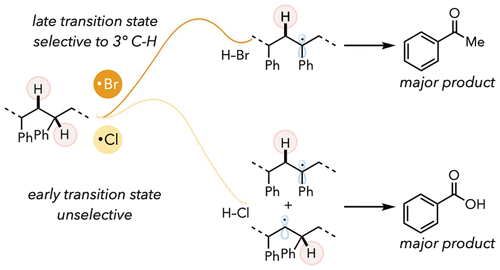ACS Catal. 2023, 13, 16, 10968–10975
Research Article
Publication Abstract
Polystyrene upcycling to valuable commodity feedstocks is essential for reducing plastic waste. Photooxidative degradation has emerged as a method for converting polystyrene to oxidized aromatic compounds. Investigating the mechanism of photooxidative degradation is essential for understanding the pathways to generating different small molecules. Here, we leveraged the reactivity differences between chlorine and bromine radicals to study the degradation mechanism of polystyrene. While degradation with chlorine radical yields primarily benzoic acid (50 mol %), bromine radical shows an increased preference for acetophenone (4 mol % for both products). After conducting several mechanistic studies, we discovered that activation of 3° C–H bonds is necessary to form acetophenone. However, for acetophenone production, a second hydrogen atom transfer from H–Br enables the reformation of a methyl group on the polymer chain end. Lastly, with the mechanistic insights in hand, we added exogenous bromine sources to increase the concentration of HBr and improved the acetophenone yield, becoming the major degradation product. We envision that our insights into the polystyrene degradation mechanism will further enable divergent product selectivity.

